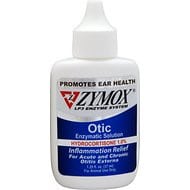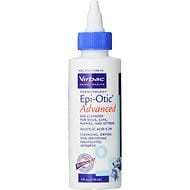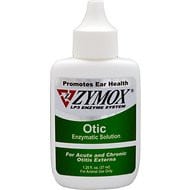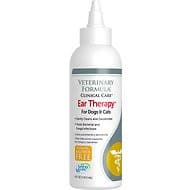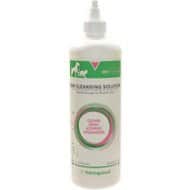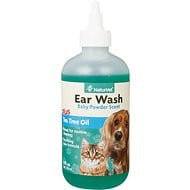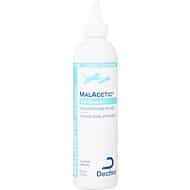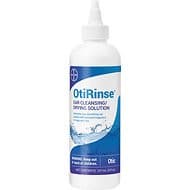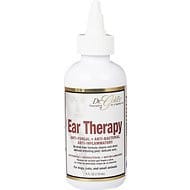Contents
- What Is The Best Cat Ear Cleaner?
- What You Need to Know About Cat Ear Infections
- How to Clean Your Cat’s Ears
- The Best Cat Ear Cleaner
- Zymox Otic Pet Ear Treatment with Hydrocortisone
- Virbac Epi-Otic Advanced Ear Cleaner for Dogs & Cats
- Zymox Otic Pet Ear Treatment without Hydrocortisone
- Veterinary Formula Clinical Care Ear Therapy
- Vetoquinol Vet Solutions Ear Cleaning Solution
- NaturVet Ear Wash with Tea Tree Oil
- MalAcetic Otic Cleanser for Dogs & Cats
- OtiRinse Ear Cleansing/Drying Solution for Dogs & Cats
- Dr. Gold’s Ear Therapy for Dogs & Cats
- Frequently Asked Questions
With all the time your cat spends grooming himself, you may not feel like it’s important to check his work. As long as his coat isn’t horribly tangled or matted, you might consider it a job well done.
The trouble is that many of the most common health issues that affect cats aren’t always outwardly visible. For example, ear problems in cats are pretty common but many cat owners fail to notice them. Some cats have long fur covering their ears and some are touchy about where they’ll let you pet them. As a cat owner, however, it’s your job to keep an eye out for infections and other ear issues.
In this article, we’ll explore the subject of cat ear infections and how to keep your cat’s ears clean. You’ll learn some helpful tips and see our top picks for the best cat ear cleaning solution.
What Is The Best Cat Ear Cleaner?
- Zymox Otic Pet Ear Treatment with Hydrocortisone
- Virbac Epi-Otic Advanced Ear Cleaner
- Zymox Otic Pet Ear Treatment without Hydrocortisone
- Veterinary Formula Clinical Care Ear Therapy
- Vetoquinol Vet Solutions Ear Cleaning Solution
- NaturVet Ear Wash with Tea Tree Oil
- MalAcetic Otic Cleanser for Dogs & Cats
- OtiRinse Ear Cleansing/Drying Solution
- Dr. Gold’s Ear Therapy for Dogs & Cats
What You Need to Know About Cat Ear Infections
Ear infections are pretty common in dogs, especially dogs with long fur or ears that hang down on either side of their head. If the inside of the ears gets wet, they might not dry properly and that becomes a breeding ground for bacteria. Your cat probably doesn’t spend much time swimming and he only gets the occasional bath. Even so, he is still at risk for ear problems like infections and parasites.
Though ear infections may be less common in cats than in dogs, they can be very complex when they happen. The first thing your vet will want to do is rule out cat ear mites. From there, your cat may require other tests to determine whether the infection is secondary to some other health problem. Paying attention to your cat’s symptoms is important so you can give your vet information to go on.
Here are some of the symptoms of ear infections in cats:
- Dark or yellowish discharge
- Redness or swelling of the ear flap
- Strong odor from the ear
- Waxy buildup near the ear canal
- Hearing loss
- Loss of balance, disorientation
- Pawing at the ears
- Tilting or shaking the head
The most common type of ear infection in cats is called otitis externa, or inflammation of the outer ear canal. Otitis media, inflammation of the inner ear canal, is the most common type in humans.
Cat ear mites are a common cause for ear infections and the most obvious sign is dark discharge in the ears that looks like coffee grounds. If it isn’t ear mites, the infection could be the result of a systemic problem like allergies or it could be related to a foreign body in the ear. The treatment depends on the cause of the infection and will be up to your vet to determine.
How to Clean Your Cat’s Ears
Before cleaning your cat’s ears, it’s important to take a closer look. If you haven’t already seen a veterinarian, check for inflammation (redness) and odor so you can report these symptoms. Be gentle with your cat, especially if his ears are already irritated, and avoid putting anything too far into the ear.
Here’s a step-by-step guide to cleaning your cat’s ears:
- Place your cat in a comfortable position – swaddling him in a towel may help keep him still while you clean his ears.
- Gently grasp the tip of your cat’s ear and pull back slightly to expose the ear canal.
- While holding your cat’s ear back with one hand, squeeze a few drops of cat ear cleaner into the ear canal – it’s okay to fill the canal but don’t put the tip of the bottle into your cat’s ear.
- Keep holding the tip of the ear and massage the base of the ear with the other hand for about 30 seconds to distribute the cleaning solution.
- Use a clean cotton ball or pad to wipe out the debris – wipe outward from the inner ear canal then clean the external part of the ear.
- Let your cat shake his head then use another cotton ball to clean out any remaining debris.
Now that you know what causes ear infections in cats and how to keep your cat’s ears clean, you’re ready to start shopping around for the best cat ear cleaning solution. Read on to see what to look for and to review our top picks for the best cat ear cleaner.
The Best Cat Ear Cleaner
When shopping for cat ear cleaning solution, it’s important to choose a product designed for cats. Your cat’s skin has a different pH than yours, so the wrong product might cause irritation. Check the ingredients as well and avoid anything that contains alcohol or too many chemical additives, especially fragrance. If your cat has been diagnosed with an ear infection, ask your veterinarian about antibacterial or antifungal ingredients to look for.
Here are our top picks for the best ear cleaner for cats:
| Our 2024 Picks: Best Cat Ear Cleaner | |||
Zymox Otic Pet Ear Treatment with Hydrocortisone
|
CHECK PRICE | ||
Virbac Epi-Otic Advanced Ear Cleaner for Dogs & Cats
|
CHECK PRICE | ||
Zymox Otic Pet Ear Treatment without Hydrocortisone
|
CHECK PRICE | ||
Veterinary Formula Clinical Care Ear Therapy
|
CHECK PRICE | ||
Vetoquinol Vet Solutions Ear Cleaning Solution
|
CHECK PRICE | ||
NaturVet Ear Wash with Tea Tree Oil
|
CHECK PRICE | ||
MalAcetic Otic Cleanser for Dogs & Cats
|
CHECK PRICE | ||
OtiRinse Ear Cleansing/Drying Solution for Dogs & Cats
|
CHECK PRICE | ||
Dr. Gold’s Ear Therapy for Dogs & Cats
|
CHECK PRICE | ||
Zymox Otic Pet Ear Treatment with Hydrocortisone
Easily one of the most popular cat ear cleaners on the market, this formula contains 1% hydrocortisone to relieve itching and inflammation. This Zymox Otic Pet Ear Treatment with Hydrocortisone acts as both an ear cleaner and a treatment, all in a single daily application. It also contains three active enzymes with antiviral, antifungal, and antibacterial properties to treat acute and chronic otitis externa caused by yeast, fungal, and bacterial infections.
Pros: Contains hydrocortisone for inflammation and itching, three active enzyme ingredients
Cons: May require repeated applications for maximum benefit
Virbac Epi-Otic Advanced Ear Cleaner for Dogs & Cats
Featuring salicylic acid as an active ingredient, this non-irritating ear cleaner for cats and dogs delivers microbial action for chronic otitis externa. This ear cleaner has a low pH, so it won’t affect other ear treatments, and it removes debris and excessive wax while drying the ear canal. This formula is non-irritating and safe for routine use, even in sensitive ears.
Pros: Recommended for chronic otitis externa, safe for sensitive ears, non-irritating solution
Cons: Some users found the smell to be too strong
Zymox Otic Pet Ear Treatment without Hydrocortisone
Designed to address issues related to both acute and chronic otitis externa, this Zymox Otic Pet Ear Treatment without Hydrocortisone contains bio-active enzymes that deliver antibacterial, antifungal, and antiviral benefits. This solution reduces inflammation while acting as both an ear cleaner and treatment. It should not be used in conjunction with other topical ear medications.
Pros: Three bio-active enzymes, reduces inflammation, acts as a cleaner and ear treatment
Cons: Not intended for use with other topical medications or ear cleaners
Veterinary Formula Clinical Care Ear Therapy
Clean, disinfect, and deodorize your cat’s ears all in one gentle formula with this Veterinary Formula Clinical Care Ear Therapy solution. This ear cleaner is alcohol-free and gentle on sensitive skin, perfect for regular use. It cleans and disinfects the ears while removing foul odor and it treats common ear infections caused by bacteria and fungus.
Pros: Gentle enough for regular use, alcohol-free formula, cleans and disinfects the ears
Cons: Some users found the bottle awkward to use
Vetoquinol Vet Solutions Ear Cleaning Solution
Available in four sizes, this Vetoquinol Vet Solutions Ear Cleaning Solution is a great option for general cat ear cleaning. It features denatured alcohol (safe for cats) and lactic acid to dry and acidify the external ear canal as well as aloe vera to soften the skin. This formula is gentle enough for routine use but can be used up to 2 to 3 times per week for very dirty ears.
Pros: Gentle enough for routine use, dries and acidifies external ear canal, aloe vera to soften skin
Cons: Some users disliked the odor
NaturVet Ear Wash with Tea Tree Oil
If you’re looking for a cat ear cleaning solution made with natural ingredients, this is a good option. NaturVet Ear wash with Tea Tree Oil features tea tree oil which has natural antimicrobial properties as well as soothing aloe vera. Gentle but effective, this solution dissolves ear wax and removes foreign debris safely without irritating or damaging your cat’s sensitive skin.
Pros: Gentle formula doesn’t irritate skin, natural antimicrobial ingredients, dissolves ear wax
Cons: Has some added fragrance, some users found the green color stained light fur
MalAcetic Otic Cleanser for Dogs & Cats
For bacterial ear infections, this MalAcetic Otic Cleanser for Dogs & Cats is a great option. It offers antimicrobial benefits to fight mild to moderate bacterial and fungal infections, made with an exclusive acetic and boric acid base. This cat ear cleaner cleans and degreases to support healthy skin while also balancing the skin pH, making it unfavorable for the overgrowth of fungus and yeast.
Pros: Antimicrobial benefits, fights fungal and bacterial skin infections, balances skin surface pH
Cons: Some found the apple scent too strong
OtiRinse Ear Cleansing/Drying Solution for Dogs & Cats
If you’re simply looking for a weekly ear cleaner and you don’t need something designed to treat ear infections, this OtiRinse Ear Cleansing/Drying Solution for Dogs & Cats is a great option. It delivers the same powerful clean as medicated formulas, but it doesn’t contain hydrocortisone. This formula offers antiseptic benefits with soothing aloe vera and it has a pleasant floral scent to help deal with odor.
Pros: Antiseptic solution cleans and dries, soothing aloe vera, breaks up and dislodges debris
Cons: Contains some added fragrance, not intended to treat ear infections
Dr. Gold’s Ear Therapy for Dogs & Cats
This alcohol-free formula cleans and dries without irritating your cat’s delicate skin. Dr. Gold’s Ear Therapy for Dogs & Cats offers both antifungal and antibacterial properties in a gentle formula that cleans, disinfects, and deodorizes the ears. This formula is made in the USA to be non-irritating and it effectively treats both fungal and yeast infections.
Pros: Alcohol-free formula, antifungal and antibacterial, gentle on sensitive skin
Cons: May not work for all types of infections (particularly viral infections)
Frequently Asked Questions
- How often should I clean my cat’s ears? Most cats have fairly clean ears, especially if they have good grooming habits. The trouble is most cats use the side or flats of their paws to clean their faces, so they may not be able to reach into the ears. Ear infections tend to start deeper in the ear canal, working their way outward, so even if your cat’s ears are fairly clean, he could still develop an infection. It’s a good idea to check your cat’s ears once a week and clean them if you notice an odor or an accumulation of cat ear wax. Some cats need to have their ears cleaned more often than others.
- What home remedy can I use to clean my cat’s ears? Never use products that contain alcohol to clean your cat’s ears or anything intended for human use. Cats have sensitive skin and their skin is a different pH than a human’s – something that might be fine for your own skin could irritate or damage your cat’s skin. If you’re looking for a homemade cat ear cleaning solution, DIY options include olive oil or hydrogen peroxide.
- Can you use hydrogen peroxide to clean your cat’s ears? It’s best to ask your veterinarian’s advice before trying a home remedy to clean your cat’s ears. Some veterinarians say hydrogen peroxide is safe while others recommend against it. If you choose to use hydrogen peroxide, make sure that’s what it is – never use rubbing alcohol on your cat. Keep in mind as well that some cats have more sensitive skin than others, so even hydrogen peroxide might cause irritation. It’s always best to use a product intended for cats.
- What is the black stuff in my cat’s ears? Discharge in the ears can be caused by a number of things but dark brown or black-colored discharge is often a sign of cat ear mites. The discharge is made up of an accumulation of blood, wax, debris, and the ear mites themselves. If it accumulates too much it can actually block the ear canal.
- Can I clean my cat’s ears with olive oil? Yes, you can use a drop or two of warm olive oil to clean your cat’s ears if you don’t have cat ear cleaning solution on hand. Follow the same steps as listed above, using the oil instead of the cleaner. Use a clean cotton ball or pad to wipe away any cat ear wax and make sure your cat’s ears are dry and free from excess oil when you’re done.
If your cat has been shaking his head or pawing at his ears, it’s time to check for an ear infection. Even if your cat doesn’t have an ear infection, excess ear wax can cause irritation or discomfort. Checking your cat’s ears should be part of your regular grooming sessions and they should be cleaned as needed.
When cleaning your cat’s ears, it’s important to use the right supplies. Keep some cotton balls or pads on hand and follow the recommendations above to choose the best cat ear cleaner.


